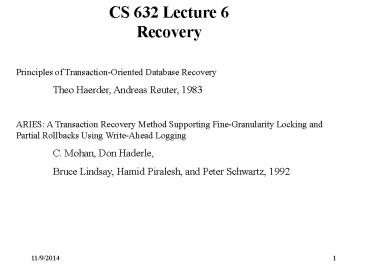CS 632 Lecture 6 - PowerPoint PPT Presentation
Title:
CS 632 Lecture 6
Description:
LSN (Log Sequence Number) unique id for each log record. Type. type of ... LSN of the previous log record written by the same. transaction that wrote the record ... – PowerPoint PPT presentation
Number of Views:26
Avg rating:3.0/5.0
Title: CS 632 Lecture 6
1
CS 632 Lecture 6 Recovery
Principles of Transaction-Oriented Database
Recovery Theo Haerder, Andreas Reuter, 1983
ARIES A Transaction Recovery Method Supporting
Fine-Granularity Locking and Partial Rollbacks
Using Write-Ahead Logging C. Mohan, Don
Haderle, Bruce Lindsay, Hamid Piralesh, and
Peter Schwartz, 1992
2
Principles of Transaction-Oriented Database
Recovery
- DATABASE RECOVERY WHAT IT IS EXPECTED TO DO
- What Is a Transaction
- Which Failures Have To Be Anticipated
- Summary of Recovery Actions
- THE MAPPING HIERARCHY OF A DBMS
- The Mapping Process
- The Storage Hierarchy
- Different Views of a Database
- Mapping Concepts for Updates
- CRASH RECOVERY
- Dependencies Between Buffer Management and
Recovery Component - Classification of Log Data
- Checkpoints
- ARCHIVE RECOVERY
3
- What is a transaction?
- actions executed indivisibly
- four properties required (the ACID properties)
- Atomicity
- all actions in the transaction happen, or none
happen - Consistency
- if a transaction preserves the consistency of the
DB - Isolation
- execution of one transaction is isolated from
that of other transactions - Durability
- if a transaction commits, its effects persist
4
Which Failures Have to Be Anticipated?
- Transaction Failures
- caused by bad input or other violations of
consistency - System Failures
- caused by
- bugs in the DBMS code
- operating system fault
- hardware failure
- occur less frequently
- Media Failures
- caused by
- software errors
- hardware errors
- physical errors
5
Summary of Recovery Actions
- Transaction Undo
- when a transaction aborts itself
- Global Undo
- when recovering from a system failure
- incomplete transactions
- Partial Redo
- when recovering from a system failure
- complete transactions
- Global Redo
- archive recovery
- full redundancy
6
(No Transcript)
7
(No Transcript)
8
Different Views of a Database
- Current database
- the contents are found on disk or in the DB
buffer - Materialized database
- the state that the DBMS finds at restart after a
crash - Physical database
- all blocks of the on-line copy
- Three types of update operations
- modification of page contents affects the
current database - write affects the physical database
- propagation affects the materialized database
9
Mapping Concepts for Updates
Two schemes for propagation
- Two types of propagation strategies
- ATOMIC
- NOT ATOMIC
10
Dependencies Between Buffer Management and
Recovery Component
- UNDO Recovery Actions
- STEAL undo actions necessary
- NO STEAL undo actions not necessary
- REDO Recovery Actions
- FORCE redo actions not necessary
- NO FORCE redo actions necessary
- Partial REDO no logging necessary
- Global REDO logging necessary
11
Classification of Log Data
- Physical State Logging on Page Level
- before image after image
- Physical Transition Logging on Page Level
- differences between old and new states
- Physical State Logging on Access Path Level
- Physical/Logical Transition Logging on the Access
Path - Logical Logging on the Record-Oriented Level
12
Checkpoints
- limit the amount of REDO recovery required after
a crash - involve three steps
- write a BEGIN_CHECKPOINT record
- write all checkpoint data
- write an END_CHECKPOINT record
- types
- Transaction-Oriented Checkpoints
- Transaction-Consistent Checkpoints
- Action-Consistent Checkpoints
- Fuzzy Checkpoints
13
(No Transcript)
14
Conclusion
- taxonomy for classifying the implementation
techniques for - database recovery
- four criteria
- Propagation
- ATOMIC/ NOT ATOMIC
- Buffer Handling
- STEAL / NO STEAL
- EOT Processing
- FORCE / NO FORCE
- Checkpointing
15
(No Transcript)
16
ARIES A Transaction Recovery Method Supporting
Fine-Granularity Locking and Partial Rollbacks
Using Write-Ahead Logging
ARIES Algorithm for Recovery and Isolation
Exploiting Semantics
17
Goals
- Simplicity
- Operation logging
- Flexible storage management
- Partial rollbacks
- Flexible buffer management
- Recovery Independence
- Logical undo
- Parallelism and fast recovery
- Minimal overhead
18
Normal Processing
- Updates
- Total or Partial Rollbacks
- savepoints
- Transaction Termination
- Checkpoints
- fuzzy checkpoints
Restart Processing
- Analysis Pass
- Redo Pass
- Undo Pass
19
(No Transcript)
20
Log Records
- LSN (Log Sequence Number)
- unique id for each log record
- Type
- type of record
- TransId
- id of transaction that wrote the record
- PrevLSN
- LSN of the previous log record written by the
same - transaction that wrote the record
- PageID
- id of the page referred by the log
- UndoNextLSN
- present in CLR
- Data
- redo/undo data describing the update
21
Page Structure
- page_LSN the LSN of the log record describing
the latest - update to the page
Transaction Table
- TransId the id of the transaction
- State
- LastLSN
- UndoNextLSN
Dirty Pages Table
- PageId
- RecLSN
22
Restart Processing
- Analysis Pass
- Redo Pass
- Undo Pass
- Selective or Deferred Restart
23
Media Recovery
- fuzzy image copy (fuzzy archive dump)
- image copy checkpoint
- media recovery redo point
Nested Top Actions
- top actions
- nested top actions

